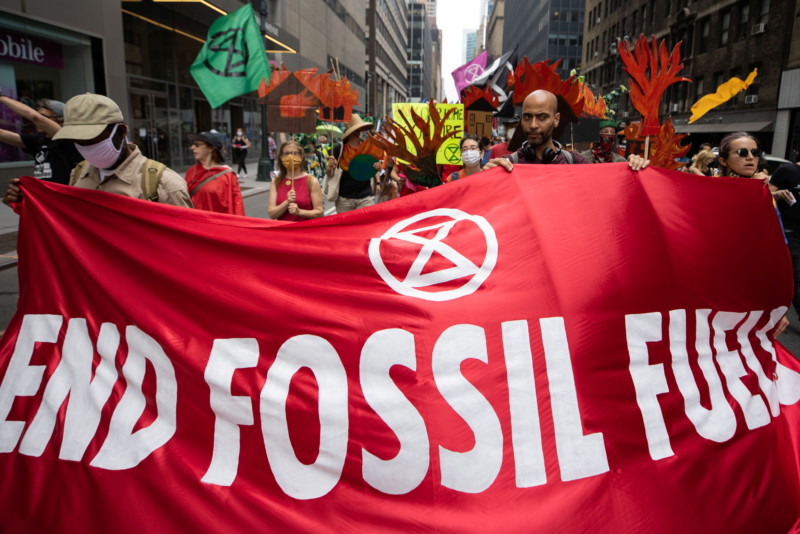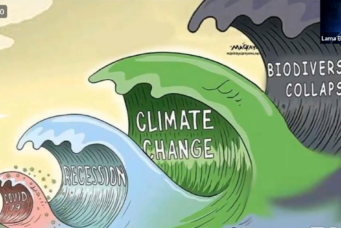The Climate Crisis Needs a Global Green New Deal
A Global Green New Deal would equitably prevent dangerous levels of warming, but it must be implemented soon.

People protest during a ‘non-violent resistance’ climate change protest organized by Extinction Rebellion in the Manhattan borough of New York City, U.S., September 17, 2021. Caitlin Ochs/Reuters.
In February, UN Secretary General Antonio Guterres called 2021 a “make-or-break year to confront the global climate emergency”. Yet, according to Robert Pollin, professor of Economics and co-director of the Political Economy Research Institute at the University of Massachusetts-Amherst, global ambition has not been sufficient enough to mark this year as a turning point. Without firm commitments to reduce carbon dioxide emissions, reduction goals will likely not be realized and global temperatures will increase past acceptable levels, Pollin said.
To achieve anything close to these goals, however, Pollin argued countries should collectively adopt what he has spent the past few years advocating: a Global Green New Deal (GGND) ambitiously aimed at achieving a zero emissions global economy. The term “Global Green New Deal” is meant to evoke Franklin Delano Roosevelt’s progressive and experimental New Deal policies of 1930s America, which aimed to provide economic relief, stabilization, and reform through federal programs and agencies. However this time, the project must embrace an ecological agenda and operate globally, on par with the scale of the crisis itself, Pollin said.
The GGND was commissioned in 2009 by the United Nations Environment Programme in response to the global food, fuel, and financial crises of 2008. It aimed to provide economic recovery, eradicate poverty, and reduce carbon emissions and environmental degradation. Pollin, and co-author Noam Chomsky, detail an updated version of the GGND in their 2020 book Climate Crisis and the Global Green New Deal. More than ten years since its inception, this project continues to advocate for “greening” the global economy to comprehensively combat climate change, providing a blueprint for net-zero carbon emissions with provisions for employment expansion and improving living conditions and public health.
Pollin’s plan, which he presented in a September webinar hosted by AUC’s John D. Gerhart Center for Philanthropy, Civic Engagement and Responsible Business, incorporates rigorous preventative action on the largest contributors to increasing global temperatures: fossil fuels and agriculture. It also includes protective measures for workers and communities dependent on the global fossil fuel infrastructure.
Citing his own research, Pollin estimated that 160 million jobs will be created per year through clean energy investments; currently, the energy sector employs around 58 million according to the International Renewable Energy Agency (IRENA). In his 2015 book, Greening the Global Economy, Pollin finds that, in six large-scale fossil fuel producing countries, investing in clean energy generated more jobs, per one million dollars spent, than investments in the existing fossil fuel infrastructure. These investments will also reap public health benefits by reducing outdoor air pollution and creating opportunities for alternative forms of ownership in the energy sector such as encouraging the rise of smaller-scale energy systems.
Simultaneously, a just transition must be provided for the workers and communities dependent on the fossil fuel industry around the world, Pollin maintained. Workers, as needed, would be provided with pensions, new job guarantees and placements, relocation, and training, while communities would benefit from the cleaning and repurposing of damaged land used for mining coal and pumping oil and gas.
Where Are We: Breaching Global Mean Temperature Targets
Evidence is mounting that the impacts of climate change are becoming increasingly severe. Droughts, heat extremes, heavy precipitation, sea level rise, and biodiversity loss are but a few examples, Pollin said. The Intergovernmental Panel on Climate Change (IPCC), a research body representing a broad scientific consensus on climate change, published a report in August which stated that by 2100, the increase in average global mean temperatures needs to be limited to1.5 degrees Celsius above pre-industrial levels (1850-1900). This is significant, Pollin explained, because prior to 2018, the IPCC accepted a 2 degree increase, but facing worsening environmental and lifestyle impacts, the target has been revised. The use of the pre-industrial levels establishes a baseline to measure the extent of human-induced warming.
Already, average temperatures stand at 1 to 1.1 degrees Celsius above pre-industrial levels. “In the last twenty years only, we have gone from a half degree above the global mean temperature to one full degree. So, if this trajectory were to continue, we will breach the 1.5 degree threshold in a mere 20 years,” he warned. “That’s where we are.”
To limit warming to 1.5 degree, the IPCC recommends two solutions; carbon dioxide emissions must be reduced by 50 percent by 2030 and eliminated entirely by 2050. However, 2030 is only eight years away, and sustained warming is recent and has occurred rapidly—it was not until 1980 that the world began to experience a persistent increase in global temperatures. “It is going to get worse,” Pollin added, “The question is how much worse and whether we have the capacity…to stabilize.”
Transitioning Out of Fossil Fuels, Industrial Agriculture
Burning fossil fuels to produce energy is responsible for roughly 70 percent of all greenhouse gas emissions and could be even higher according to the recent IPCC report.
Pollin proposed two primary alternatives to the global fossil fuel infrastructure: increased energy efficiency and the use of renewable energy sources. Increasing energy efficiency entails greater reliance on efficient public transport and electric vehicles, electric heat pumps to regulate building temperatures, LED lights, and the use of combined heat and power systems in industrial production.
“Raising energy efficiency standards can get us to the point where we will be able to stabilize our demand for energy even as the global economy grows,” Pollin argued.
To eliminate fossil fuel use by 2050, the necessary reductions in spending would result in an estimated 3.3 percent contraction per year in the global economy—if cuts were to begin now. Starting early is critical, Pollin stressed; every year cuts are postponed necessitates larger cuts in subsequent years. As for expanding the use of renewables—primarily wind and solar power but also geothermal and small-scale hydroelectric power—Pollin estimated that around 2.5 percent of global gross domestic product (GDP), or 4.5 trillion dollars annually, would need to be spent to achieve zero carbon emissions by 2050. This target would require a five-fold increase in spending as, currently, around 0.5 percent of global GDP is allocated to investments in renewables. It’s a large number, Pollin said, but it is manageable.
While this $4.5 trillion annual commitment applies to both advanced and developing countries alike, Pollin proposed advanced economies finance the project almost entirely themselves. “The advanced economies are responsible for having created climate change, for creating the crisis,” said Pollin. “We bear the responsibility to deliver the financing.”
From a business perspective, renewables just make sense, Pollin argued; 62 percent of newly installed renewables for power generation are cheaper than the cheapest fossil fuel alternative.
“The simplest answer is: these are efficient technologies; they are available right now; they are cheap, and they work. They’re safe,” Pollin said. Nuclear energy is not cheap, Pollin argued, and carbon capture has not yet been proven on an industrial scale. Moreover, solar, wind, and geothermal energy are roughly half the cost of both nuclear energy and burning coal with carbon capture. “I don’t see there being any choice if we take climate science seriously. Therefore, we have to transition out of fossil fuels,” Pollin said. “We have to do it now.”
Agriculture, meanwhile, accounts for close to the remaining 30 percent of greenhouse gas emissions. Deforestation releases carbon dioxide into the atmosphere, and then leaves forests without their previous absorption capacity for forty to fifty years until trees regrow. Dominant industrial agricultural practices, heavily reliant on nitrogen fertilizer, leave the soil devoid of its natural carbon dioxide absorption capacity. A focus on reforestation and organic agriculture will increase natural carbon capture, Pollin asserted.
Benefits of Adopting the Global Green New Deal
Adopting the Global Green New Deal is not a choice if we take climate science seriously, Pollin stressed. We cannot use problems with renewable alternatives as an excuse to avoid the transition out of fossil fuels. The costs of clean energy are low, and the technologies are available and will create jobs, Pollin stressed.
In the short term, investing will create jobs that will help mitigate the global recession caused by the COVID-19 pandemic. In the long term, Pollin stated, the Global Green New Deal is a climate stabilization project which will create decent work opportunities and contribute to fighting poverty and raising mass living standards.
“It’s the way to go,” Pollin stressed. “The Green New Deal is available to us right now.” But adequate commitments from the global community are lacking. However, if implemented, the GGND would address the stark reality of the climate crisis, which is severe, global, and occurring rapidly. It would provide realistic and safe alternatives to supplant the dominant carbon-emitting economy, Pollin said, and the sooner countries pursue it, the better.




